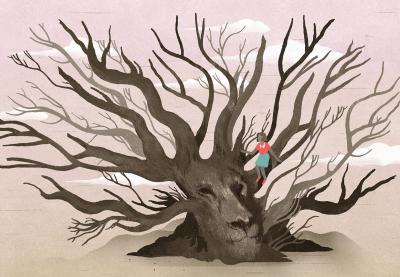Many citizens of our country—including many educators—wish to believe that major symbolic societal changes (election of a black president, growing numbers of upper-class families of color) demonstrate racial progress in our nation. This is far from the truth. We have not progressed as much as we would like to believe—not for all people of color, or for those who are poor.
The crippling state of American race relations is not simply a matter of morality or decay of civil rights motivation. It is mostly a matter of knowledge deficits, of skill deficits and of fear. Moral people or people who become enlightened don’t suddenly become knowledgeable. Even if we awaken to the struggles of the world, we still require practice, teaching, learning and more practice over much time before claiming to be talented, knowledgeable or competent. This is true for anything we wish to be good at, and it is true of race relations.
The Monster of Racial Stress
Our deficits and fears are rooted in how little we know about families and individuals who are different from us. This racial ignorance becomes like a monster that terrorizes the daily lives of people of color. People of color may not even be aware of the racial stress they experience or of their triumphs in spite of the monster. It is human to not want to see or feel our past hurt and pain—but can healing take place without such an examination?
A West African proverb tells us, “The lion’s story will never be known as long as the hunter is the one to tell it.” This proverb serves as the thematic cry for my work. How does a lion learn to tell a story that isn’t filtered through the distorted stereotypes about lions or the subtle heroic supremacy of the hunter? Why do the hunters get the press coverage and the lions live in zoos?
It takes practice for children of color to emotionally remember, process and appreciate their own life experiences, both personal and racial. The energy these young people expend to repress, avoid or manage racial encounters may make it impossible to recount them. In a country where black students are disproportionately suspended and expelled from school without due process and where research tells us we view black boys as less innocent than white boys, telling these stories is often just too painful.
Not knowing how racial relationships stress us or how we consciously or unconsciously cope during race relations leads to a kind of racial illiteracy. But knowing these aspects of ourselves allows us to change and grow.
Racial storytelling allows us to identify what stresses us, how we cope with and react to racial stress and how we hide emotionally. It undermines the tendency to question one’s own experience, to belittle the experience of someone else, to walk arrogantly in spite of another’s pain, to deny the racial disparities of health, justice and compassion all around us, and to pretend that all of our life experiences are universal. Racial storytelling is the first step to healing racial fear, its accompanying shame and its morbid influence. Without racial storytelling, educators, politicians, parents, law enforcement and children are stuck tolerating differences, acquiescing to levels of racial avoidance rather than committing to the higher ground of racial literacy and competence—of humanity.
My Mother’s Story
I grew up in a multicultural household even though both of my parents were African American. My mother was a connoisseur of contemporary and historical knowledge, music and literature of the highest order, and she read voluminously. She made sure that our childhood was full of reading and music from various cultural sources, and our second home was the local library in Milton, Delaware. We were exposed to Jet, Ebony, Time, Look, Life, Reader’s Digest and weekly newspapers. If we had little money available, you could bet that books would still be on the priority list of things to buy. My mother’s musical exposure covered classical, jazz, gospel, blues and soul, broadly defined. Stevie Wonder was a musical staple in our house, and my brother and sister and I could recite most of the words from (and dance feverishly in rhythm to) the entire Songs in the Key of Life album. Stevie Wonder’s music was a racial socialization watershed, as both racial calamity and racial triumph were dealt with throughout his lyrics and music. That album remains as a healing artifact of my existence.I witnessed with great sadness the assassination and funeral of John F. Kennedy, whose reputation had previously made no impression on me and my siblings, as we were children at the time. But our mother’s sadness struck me powerfully. At five, I knew his death was a monumental event because I remember her words of sorrow and tears of pain and fear that if they could shoot the president over his efforts to fight racial injustice, then no black child was safe. Her black children were not safe. She worried constantly about the insidiousness of and acquiescence to racial disparity and hierarchy. This was stressful.
Racial storytelling is the first step to healing racial fear.
In our travels to supermarkets, libraries and other public establishments, my mother was keen on teaching us about the attitudes of whites who could not hold back their disgust at our presence. She frequently challenged the police when they stopped our car (which frightened my brother, sister and me), and while nothing negative happened as a result of her standing up for herself, that doesn’t mean it wasn’t stressful. When she would come to school, teachers would run to the corners of the school hoping not to have to deal with her. She did not play when it came to school if her children were being mistreated or perceived as not talented. We were often shielded from racial injustice at school because my mother hovered over the place like a hawk, waiting to pounce on any teacher who didn’t get it. Along the way, she made some amazing allies among teachers who were serious about teaching black children with an understanding of the stormy racial climate of the 1960s.
As I grew older, I began to understand her burden of being the one who called out the injustices of the world, of the country, of the local school system. While parenting is stressful for anyone who has children, parents of color experience different levels and types of stress and, thus, different health consequences.
Hearing the Lion
My mother’s story is both unique and common. Many parents struggle with the stress of parenting children within hostile neighborhoods and surroundings, where their stress compounds because others don’t know about it. Not everyone has to worry whether police officers will view them, their friends or their children as menaces to society—or shoot them without due process—because of the color of their skin. Not everyone has to be aware of the fear in the eyes of authority figures as a sign that they should change their behavior or else risk unjust treatment, threat to their future or physical harm. Not everyone has to manage unconscious bias that comes from well-meaning educators who hamper achievement and career opportunities and outcomes for children of color.
Healthy racial storytelling means sharing what those realities mean to us emotionally. It’s an emotional sharing moment that affects our physical well-being. Stereotypes are stories of static identities. Healthy racial storytelling is about fluid identities and meaning-making. It encourages meaning-making and emotional reattachment to a painful past, but also to a promising future relationship. Healthy racial storytelling builds compassion. It reveals weakness and humility and provides the opportunity for forgiveness of the former and expression of the latter—expressions rarely seen in today’s debate on racial progress.
By placing ourselves at the center of the story of racial stress and socialization, where weaknesses and strengths can be excavated, administrators, teachers, parents and students can bring a story of their own to multicultural conversations. Instead of feeling helpless in a multicultural context, individuals can learn how to locate racial shame without pretense and choose to share rather than be devastated by feelings of shame and reticence.
By telling our racial stories, we can observe and silence the monster within us and engage rather than avoid racial difference—and begin to hear the lions.
Stevenson is a professor of urban education and Africana studies at the University of Pennsylvania.

